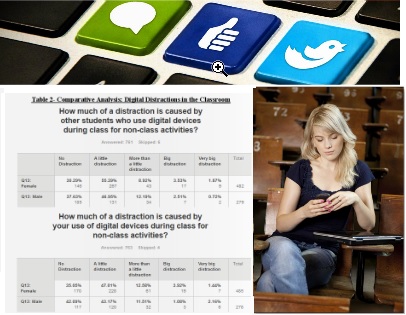 Survey proves the obvious: students are distracted by gadgets.[/caption] The Internet of Things and Big Data analytics promise to shine a light into dark corners of ignorance about human behavior, places where most of us don't even suspect corners exist. However original or unsuspected the results, however, it turns out that having a really smart way to get a better answer to a particular problem doesn't the answer itself any more valuable. Researchers at MIT's Newman Laboratory for Biomechanics and Human Rehabilitation, for example, have built a semi-autonomous, artificial-intelligence-imbued robotic device whose job it is to determine whether the wearer's ankle is stiff. The machine, named "Ankelbot," attaches to a knee brace and a custom-designed shoe with which it moves the wearer's foot along a specific trajectory, bending in different directions to calculate whether the joint is stiff or not. "Imagine you have a collection of pebbles, and you wrap a whole bunch of elastic bands around them," lead researcher Neville Hogan, the Sun Jae Professor of Mechanical Engineering at MIT, wrote in the announcement of Anklebot's existence. "That’s pretty much a description of what the ankle is. It’s nowhere near a simple joint from a kinematics standpoint." Ankles are strongest when moving the foot up and down, and weaker when moving from side to side, though it turns out the mechanism the ankle uses to move side-to-side is independent of the one it uses to move up and down: a finding that might help physiologists better understand the ankle's dynamic characteristics as well as its physical properties, Hogan added. Even without previously unsuspected revelations, Anklebot data should help physical therapists and trainers create more effective recovery or rehabilitation plans, Hogan said.
Survey proves the obvious: students are distracted by gadgets.[/caption] The Internet of Things and Big Data analytics promise to shine a light into dark corners of ignorance about human behavior, places where most of us don't even suspect corners exist. However original or unsuspected the results, however, it turns out that having a really smart way to get a better answer to a particular problem doesn't the answer itself any more valuable. Researchers at MIT's Newman Laboratory for Biomechanics and Human Rehabilitation, for example, have built a semi-autonomous, artificial-intelligence-imbued robotic device whose job it is to determine whether the wearer's ankle is stiff. The machine, named "Ankelbot," attaches to a knee brace and a custom-designed shoe with which it moves the wearer's foot along a specific trajectory, bending in different directions to calculate whether the joint is stiff or not. "Imagine you have a collection of pebbles, and you wrap a whole bunch of elastic bands around them," lead researcher Neville Hogan, the Sun Jae Professor of Mechanical Engineering at MIT, wrote in the announcement of Anklebot's existence. "That’s pretty much a description of what the ankle is. It’s nowhere near a simple joint from a kinematics standpoint." Ankles are strongest when moving the foot up and down, and weaker when moving from side to side, though it turns out the mechanism the ankle uses to move side-to-side is independent of the one it uses to move up and down: a finding that might help physiologists better understand the ankle's dynamic characteristics as well as its physical properties, Hogan added. Even without previously unsuspected revelations, Anklebot data should help physical therapists and trainers create more effective recovery or rehabilitation plans, Hogan said.
Smart Devices Reveal Lots of Detail About Obvious Truths
[caption id="attachment_13430" align="aligncenter" width="406"] Survey proves the obvious: students are distracted by gadgets.[/caption] The Internet of Things and Big Data analytics promise to shine a light into dark corners of ignorance about human behavior, places where most of us don't even suspect corners exist. However original or unsuspected the results, however, it turns out that having a really smart way to get a better answer to a particular problem doesn't the answer itself any more valuable. Researchers at MIT's Newman Laboratory for Biomechanics and Human Rehabilitation, for example, have built a semi-autonomous, artificial-intelligence-imbued robotic device whose job it is to determine whether the wearer's ankle is stiff. The machine, named "Ankelbot," attaches to a knee brace and a custom-designed shoe with which it moves the wearer's foot along a specific trajectory, bending in different directions to calculate whether the joint is stiff or not. "Imagine you have a collection of pebbles, and you wrap a whole bunch of elastic bands around them," lead researcher Neville Hogan, the Sun Jae Professor of Mechanical Engineering at MIT, wrote in the announcement of Anklebot's existence. "That’s pretty much a description of what the ankle is. It’s nowhere near a simple joint from a kinematics standpoint." Ankles are strongest when moving the foot up and down, and weaker when moving from side to side, though it turns out the mechanism the ankle uses to move side-to-side is independent of the one it uses to move up and down: a finding that might help physiologists better understand the ankle's dynamic characteristics as well as its physical properties, Hogan added. Even without previously unsuspected revelations, Anklebot data should help physical therapists and trainers create more effective recovery or rehabilitation plans, Hogan said.
Survey proves the obvious: students are distracted by gadgets.[/caption] The Internet of Things and Big Data analytics promise to shine a light into dark corners of ignorance about human behavior, places where most of us don't even suspect corners exist. However original or unsuspected the results, however, it turns out that having a really smart way to get a better answer to a particular problem doesn't the answer itself any more valuable. Researchers at MIT's Newman Laboratory for Biomechanics and Human Rehabilitation, for example, have built a semi-autonomous, artificial-intelligence-imbued robotic device whose job it is to determine whether the wearer's ankle is stiff. The machine, named "Ankelbot," attaches to a knee brace and a custom-designed shoe with which it moves the wearer's foot along a specific trajectory, bending in different directions to calculate whether the joint is stiff or not. "Imagine you have a collection of pebbles, and you wrap a whole bunch of elastic bands around them," lead researcher Neville Hogan, the Sun Jae Professor of Mechanical Engineering at MIT, wrote in the announcement of Anklebot's existence. "That’s pretty much a description of what the ankle is. It’s nowhere near a simple joint from a kinematics standpoint." Ankles are strongest when moving the foot up and down, and weaker when moving from side to side, though it turns out the mechanism the ankle uses to move side-to-side is independent of the one it uses to move up and down: a finding that might help physiologists better understand the ankle's dynamic characteristics as well as its physical properties, Hogan added. Even without previously unsuspected revelations, Anklebot data should help physical therapists and trainers create more effective recovery or rehabilitation plans, Hogan said.
 Survey proves the obvious: students are distracted by gadgets.[/caption] The Internet of Things and Big Data analytics promise to shine a light into dark corners of ignorance about human behavior, places where most of us don't even suspect corners exist. However original or unsuspected the results, however, it turns out that having a really smart way to get a better answer to a particular problem doesn't the answer itself any more valuable. Researchers at MIT's Newman Laboratory for Biomechanics and Human Rehabilitation, for example, have built a semi-autonomous, artificial-intelligence-imbued robotic device whose job it is to determine whether the wearer's ankle is stiff. The machine, named "Ankelbot," attaches to a knee brace and a custom-designed shoe with which it moves the wearer's foot along a specific trajectory, bending in different directions to calculate whether the joint is stiff or not. "Imagine you have a collection of pebbles, and you wrap a whole bunch of elastic bands around them," lead researcher Neville Hogan, the Sun Jae Professor of Mechanical Engineering at MIT, wrote in the announcement of Anklebot's existence. "That’s pretty much a description of what the ankle is. It’s nowhere near a simple joint from a kinematics standpoint." Ankles are strongest when moving the foot up and down, and weaker when moving from side to side, though it turns out the mechanism the ankle uses to move side-to-side is independent of the one it uses to move up and down: a finding that might help physiologists better understand the ankle's dynamic characteristics as well as its physical properties, Hogan added. Even without previously unsuspected revelations, Anklebot data should help physical therapists and trainers create more effective recovery or rehabilitation plans, Hogan said.
Survey proves the obvious: students are distracted by gadgets.[/caption] The Internet of Things and Big Data analytics promise to shine a light into dark corners of ignorance about human behavior, places where most of us don't even suspect corners exist. However original or unsuspected the results, however, it turns out that having a really smart way to get a better answer to a particular problem doesn't the answer itself any more valuable. Researchers at MIT's Newman Laboratory for Biomechanics and Human Rehabilitation, for example, have built a semi-autonomous, artificial-intelligence-imbued robotic device whose job it is to determine whether the wearer's ankle is stiff. The machine, named "Ankelbot," attaches to a knee brace and a custom-designed shoe with which it moves the wearer's foot along a specific trajectory, bending in different directions to calculate whether the joint is stiff or not. "Imagine you have a collection of pebbles, and you wrap a whole bunch of elastic bands around them," lead researcher Neville Hogan, the Sun Jae Professor of Mechanical Engineering at MIT, wrote in the announcement of Anklebot's existence. "That’s pretty much a description of what the ankle is. It’s nowhere near a simple joint from a kinematics standpoint." Ankles are strongest when moving the foot up and down, and weaker when moving from side to side, though it turns out the mechanism the ankle uses to move side-to-side is independent of the one it uses to move up and down: a finding that might help physiologists better understand the ankle's dynamic characteristics as well as its physical properties, Hogan added. Even without previously unsuspected revelations, Anklebot data should help physical therapists and trainers create more effective recovery or rehabilitation plans, Hogan said.
